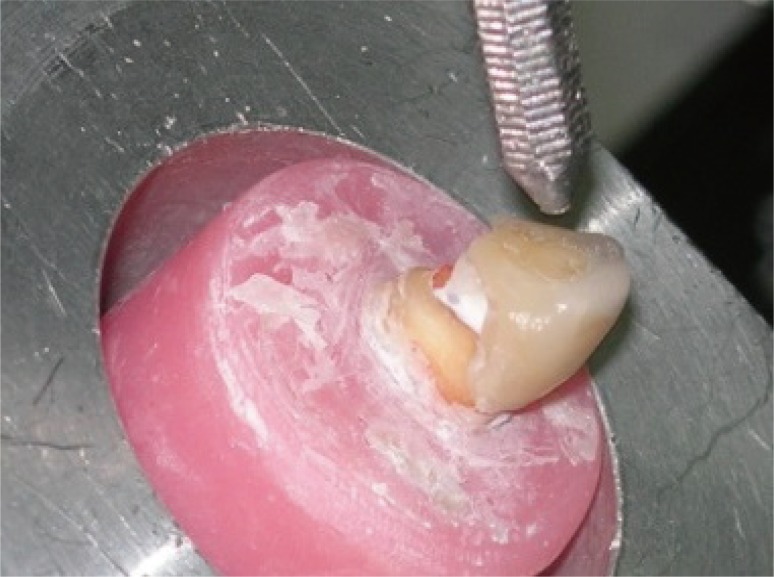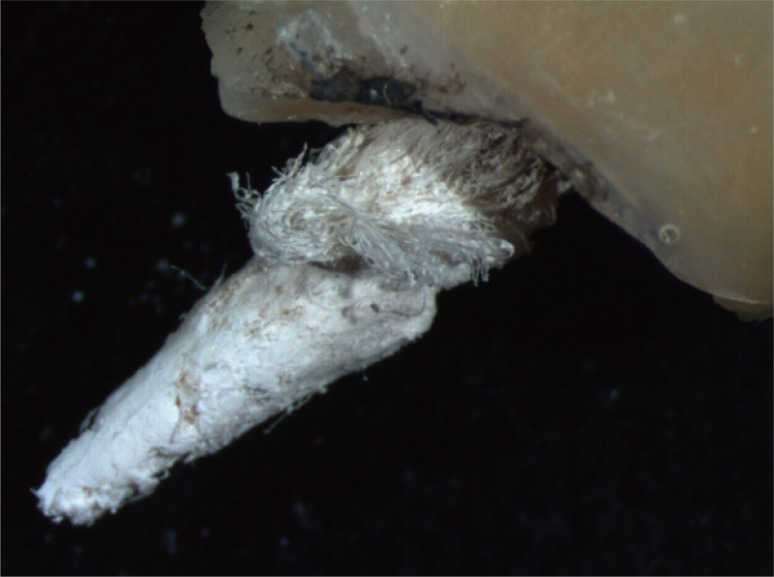J Adv Prosthodont.
2016 Apr;8(2):158-166. 10.4047/jap.2016.8.2.158.
Fracture resistance of endodontically treated canines restored with different sizes of fiber post and all-ceramic crowns
- Affiliations
-
- 1Department of Prosthodontics, Faculty of Dentistry - Marmara University, Istanbul, Turkey. begumturker@hotmail.com
- 2Department of Prosthodontics, Schulich School of Medicine and Dentistry, University of Western Ontario, Toronto, Canada.
- KMID: 2176659
- DOI: http://doi.org/10.4047/jap.2016.8.2.158
Abstract
- PURPOSE
The aim of this study was to determine the fracture resistance and the mode of fracture of endodontically treated teeth restored with different fiber posts and all-ceramic crowns.
MATERIALS AND METHODS
Two glass fiber reinforced post systems in two different sizes and polyethylene fiber ribbon in two different thicknesses (n=10) were used. The specimens, restored with all-ceramic crowns, were subjected to a compressive load (in N) delivered at a 130-degree angle to the long axis until a fracture could be noted. The results were analyzed statistically with a One-Way ANOVA test (P<.05).
RESULTS
Statistically significant differences were observed between the mean fracture resistance values of Postec, Snowlight, and Kerr Connect thin specimens (P<.0095). The Postec results (395.70 N) were found to be significantly higher than the others. No statistical difference was observed among the thick specimens (P<.2657). The mean fracture resistance values of the Snowlight thick samples were found to be higher than those of the Snowlight thin samples. The specimens were always fractured around the cemento-enamel junction at the palatinal side. No post fracture was observed for the thin Snowlight and Kerr Connect specimens or for the thick Postec and Kerr Connect specimens. Among the common failure types of the specimens, the worst was observed to be the root fracture failure. The highest post dislodgement failure result (80%) was obtained from the thin Kerr Connect specimen.
CONCLUSION
In terms of optimizing fracture resistance, the fiber post size selection should be done according to the forces applied to the restored teeth.
Figure
Reference
-
1. Robbins JW. Restoration of the endodontically treated tooth. Dent Clin North Am. 2002; 46:367–384. PMID: 12014038.2. Torbjörner A, Karlsson S, Odman PA. Survival rate and failure characteristics for two post designs. J Prosthet Dent. 1995; 73:439–444. PMID: 7658393.
Article3. Viguie G, Malquarti G, Vincent B, Bourgeois D. Epoxy/carbon composite resins in dentistry: mechanical properties related to fiber reinforcements. J Prosthet Dent. 1994; 72:245–249. PMID: 7965896.
Article4. Lima AF, Spazzin AO, Galafassi D, Correr-Sobrinho L, Carlini-Júnior B. Influence of ferrule preparation with or without glass fiber post on fracture resistance of endodontically treated teeth. J Appl Oral Sci. 2010; 18:360–363. PMID: 20835570.
Article5. Lassila LV, Tanner J, Le Bell AM, Narva K, Vallittu PK. Flexural properties of fiber reinforced root canal posts. Dent Mater. 2004; 20:29–36. PMID: 14698771.
Article6. Maroulakos G, Nagy WW, Kontogiorgos ED. Fracture resistance of compromised endodontically treated teeth restored with bonded post and cores: An in vitro study. J Prosthet Dent. 2015; 114:390–397. PMID: 26047799.7. Bateman G, Ricketts DN, Saunders WP. Fibre-based post systems: a review. Br Dent J. 2003; 195:43–48. discussion 37PMID: 12856030.
Article8. Fragou T, Tortopidis D, Kontonasaki E, Evangelinaki E, Ioannidis K, Petridis H, Koidis P. The effect of ferrule on the fracture mode of endodontically treated canines restored with fibre posts and metal-ceramic or all-ceramic crowns. J Dent. 2012; 40:276–285. PMID: 22265988.
Article9. Duret B, Duret F, Reynaud M. Long-life physical property preservation and postendodontic rehabilitation with the Composipost. Compend Contin Educ Dent Suppl. 1996; 20:S50–S56. PMID: 12089762.10. Fredriksson M, Astbäck J, Pamenius M, Arvidson K. A retrospective study of 236 patients with teeth restored by carbon fiber-reinforced epoxy resin posts. J Prosthet Dent. 1998; 80:151–157. PMID: 9710815.
Article11. Ferrari M, Vichi A, Mannocci F, Mason PN. Retrospective study of the clinical performance of fiber posts. Am J Dent. 2000; 13:9B–13B.12. Balbosh A, Kern M. Effect of surface treatment on retention of glass-fiber endodontic posts. J Prosthet Dent. 2006; 95:218–223. PMID: 16543019.
Article13. Rudo DN, Karbhari VM. Physical behaviors of fiber reinforcement as applied to tooth stabilization. Dent Clin North Am. 1999; 43:7–35. PMID: 9929797.14. Turker SB, Alkumru HN, Evren B. Prospective clinical trial of polyethylene fiber ribbon-reinforced, resin composite post-core buildup restorations. Int J Prosthodont. 2007; 20:55–56. PMID: 17319364.15. Turner CH. Cement distribution during post cementation. J Dent. 1981; 9:231–239. PMID: 7024356.
Article16. Mendoza DB, Eakle WS, Kahl EA, Ho R. Root reinforcement with a resin-bonded preformed post. J Prosthet Dent. 1997; 78:10–14. PMID: 9237140.
Article17. Mannocci F, Ferrari M, Watson TF. Intermittent loading of teeth restored using quartz fiber, carbon-quartz fiber, and zirconium dioxide ceramic root canal posts. J Adhes Dent. 1999; 1:153–158. PMID: 11725680.18. Stockton LW. Factors affecting retention of post systems: a literature review. J Prosthet Dent. 1999; 81:380–385. PMID: 10095205.
Article19. Sahafi A, Peutzfeldt A, Asmussen E, Gotfredsen K. Retention and failure morphology of prefabricated posts. Int J Prosthodont. 2004; 17:307–312. PMID: 15237877.20. Cohen BI, Condos S, Deutsch AS, Musikant BL. Fracture strength of three different core materials in combination with three different endodontic posts. Int J Prosthodont. 1994; 7:178–182. PMID: 8003200.21. Yaman P, Thorsteinsson TS. Effect of core materials on stress distribution of posts. J Prosthet Dent. 1992; 68:416–420. PMID: 1432754.
Article22. Sadek FT, Monticelli F, Goracci C, Tay FR, Cardoso PE, Ferrari M. Bond strength performance of different resin composites used as core materials around fiber posts. Dent Mater. 2007; 23:95–99. PMID: 16434092.
Article23. Isidor F, Brøndum K, Ravnholt G. The influence of post length and crown ferrule length on the resistance to cyclic loading of bovine teeth with prefabricated titanium posts. Int J Prosthodont. 1999; 12:78–82. PMID: 10196832.24. Sokol DJ. Effective use of current core and post concepts. J Prosthet Dent. 1984; 52:231–234. PMID: 6381706.
Article25. Standlee JP, Caputo AA, Holcomb J, Trabert KC. The retentive and stress-distributing properties of a threaded endodontic dowel. J Prosthet Dent. 1980; 44:398–404. PMID: 6997468.
Article26. Holmes DC, Diaz-Arnold AM, Leary JM. Influence of post dimension on stress distribution in dentin. J Prosthet Dent. 1996; 75:140–147. PMID: 8667271.
Article27. Sirimai S, Riis DN, Morgano SM. An in vitro study of the fracture resistance and the incidence ofvertical root fracture of pulpless teeth restored with six post-and-coresystems. J Prosthet Dent. 1999; 81:262–269. PMID: 10050112.28. Kelly JR. Approaching clinical relevance in failure testing of restorations. J Prosthet Dent. 1999; 81:652–661. PMID: 10347352.29. Assif D, Bitenski A, Pilo R, Oren E. Effect of post design n resistance to fracture of endodontically treated teeth with complete crowns. J Prosthet Dent. 1993; 69:36–40. PMID: 8455166.30. Pereira JR, de Ornelas F, Conti PC, do Valle AL. Effect of a crown ferrule on the fracture resistance of endodontically treated teeth restored with prefabricated posts. J Prosthet Dent. 2006; 95:50–54. PMID: 16399275.
Article31. Cormier CJ, Burns DR, Moon P. In vitro comparison of the fracture resistance and failure mode of fiber, ceramic, and conventional post systems at various stages of restoration. J Prosthodont. 2001; 10:26–36. PMID: 11406793.
Article32. Al-Wahadni AM, Hamdan S, Al-Omiri M, Hammad MM, Hatamleh MM. Fracture resistance of teeth restored with different post systems: in vitro study. Oral Surg Oral Med Oral Pathol Oral Radiol Endod. 2008; 106:e77–e83. PMID: 18554954.
Article33. Stricker EJ, Göhring TN. Influence of different posts and cores on marginal adaptation, fracture resistance, and fracture mode of composite resin crowns on human mandibular premolars. An in vitro study. J Dent. 2006; 34:326–335. PMID: 16202498.
Article34. Akkayan B. An in vitro study evaluating the effect of ferrule length on fracture resistance of endodontically treated teeth restored with fiber-reinforced and zirconia dowel systems. J Prosthet Dent. 2004; 92:155–162. PMID: 15295325.
Article35. Tan PL, Aquilino SA, Gratton DG, Stanford CM, Tan SC, Johnson WT, Dawson D. In vitro fracture resistance of endodontically treated central incisors with varying ferrule heights and configurations. J Prosthet Dent. 2005; 93:331–336. PMID: 15798683.
Article36. Eskitaşcioğlu G, Belli S, Kalkan M. Evaluation of two post core systems using two different methods (fracture strength test and a finite elemental stress analysis). J Endod. 2002; 28:629–633. PMID: 12236304.37. Giovani AR, Vansan LP, de Sousa Neto MD, Paulino SM. In vitro fracture resistance of glass-fiber and cast metal posts with different lengths. J Prosthet Dent. 2009; 101:183–188. PMID: 19231570.
Article38. de Oliveira JA, Pereira JR, Lins do, Zogheib LV. Fracture resistance of endodontically treated teeth with different heights of crown ferrule restored with prefabricated carbon fiber post and composite resin core by intermittent loading. Oral Surg Oral Med Oral Pathol Oral Radiol Endod. 2008; 106:e52–e57. PMID: 18718775.
Article39. Ma PS, Nicholls JI, Junge T, Phillips KM. Load fatigue of teeth with different ferrule lengths, restored with fiber posts, composite resin cores, and all-ceramic crowns. J Prosthet Dent. 2009; 102:229–234. PMID: 19782825.
Article40. Goodacre CJ, Campagni WV, Aquilino SA. Tooth preparations for complete crowns: an art form based on scientific principles. J Prosthet Dent. 2001; 85:363–376. PMID: 11319534.
Article41. Kovarik RE, Breeding LC, Caughman WF. Fatigue life of three core materials under simulated chewing conditions. J Prosthet Dent. 1992; 68:584–590. PMID: 1403934.
Article
- Full Text Links
- Actions
-
Cited
- CITED
-
- Close
- Share
- Similar articles
-
- Fracture resistances of zirconia, cast Ni-Cr, and fiber-glass composite posts under all-ceramic crowns in endodontically treated premolars
- Comparison of fracture strength and pattern of endodontically treated teeth restored with fiber posts and metal cast post
- Retrospective clinical and radiographic evaluation of restored endodontically treated teeth
- A comparison of the fracture resistances of endodontically treated mandibular premolars restored with endocrowns and glass fiber post-core retained conventional crowns
- Fracture resistance of upper central incisors restored with different posts and cores






